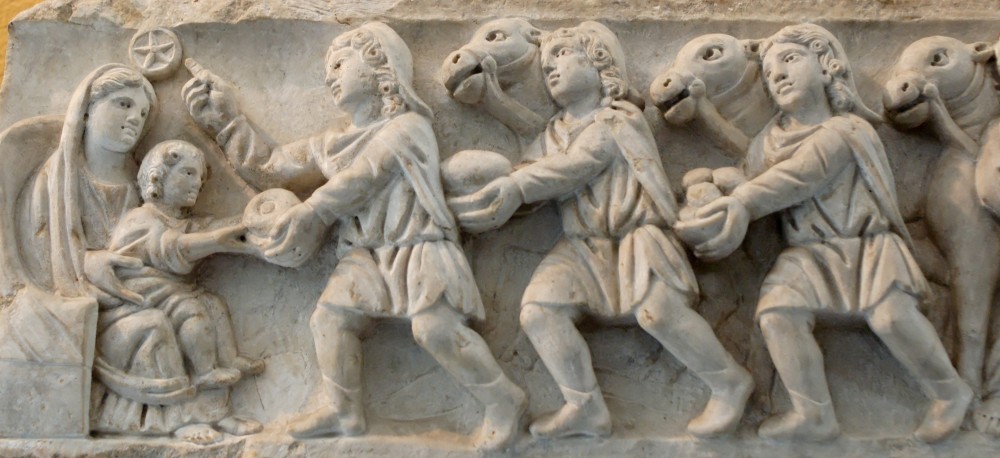The eyes of the Christ child (Matthew 2:1-12)
At the center of Epiphany is a mystery of looking. Who looks at whom?

We are used to the imagery of God communicating by God’s word, and so we think of our responses to God as aural: we listen. And obedience (from obaudiens) can be translated as “intense hearing.” Yet how much of the religion of ancient Israel was a priestly religion of presence! We forget that one of the central images of God’s communication in the scriptures is that of the shining face. From the priestly blessing of Numbers 6 to the continuous references in the psalms, it is expected that worshipers will see the radiance of God’s face, and that in its light they too will shine.
The Greek word for this radiance, this shining of the face, is epifaneia, or epiphany, and it was by no means only a benign thing. Promises of the Day of the Lord warn that its coming will be exceedingly dreadful, or awe-full (epifanhz). All this visual imagery is at the center of today’s great feast of Epiphany.
The Magi, long known as kings since they were fulfilling Psalm 72, had been looking at a star, the very Star of David that had been prophesied by another foreign magus, Balaam in Numbers 24. This radiance had led them from the East to the land of Judah. The announcement to King Herod and all Jerusalem of the proximity of the radiance generated fear. Herod thereafter had to talk to the kings secretly. When the kings arrived at the place where the child was, the star stopped and they were filled with exceeding joy. Thus the radiance has a double effect—fear and darkness come upon those who oppose it, and blessing on those who seek God’s face.
So it is at Epiphany, the feast of the shining, that we come to the end of the journey that began with the portentous announcement of the coming of the Lord, the streaming of the nations toward Zion, and the invitation to walk in the light of the Lord. Six weeks later we find ourselves with an array of kings—Herod, David, the Magi—and a plethora of portents. Yet all this is directed to a simple dwelling with a newborn child. We have become accustomed to understanding that the One coming in will do so quietly, in vulnerability, in the midst of violence, prepared for suffering. So it is easy to forget that the whole point of all those kings is that they were left in the shade by the radiance of the King of kings. The Magi had come to worship a king.
For me, at the center of this feast is a mystery of looking. Who looks at whom? As adults we tend to focus on adult looks. Matthew, with his picturesque details, trains our gaze on the strangeness of the kings, the determination and persistence of their journey, their exotic dress, their laden beasts, their rich and symbolic gifts. What might this One be who is the desire of the nations?
We are taught by the Magi to value the One who lies in the manger. He acquires worth and splendor through their eyes. That is part of what the feast gives us: models for our desire, for our adoration. With each gift we are offered a way to shift the weight of our heart in an unaccustomed direction. When the Magi offer him gold, which indicates a king, we are invited to lessen the tribute we offer to the power structures to which we belong and on which we depend; when they offer him frankincense, which indicates a priest, we are invited to tiptoe out from under the delusions of our sacred canopies, to be drawn into the jagged-edged sacrifice of presence that this Priest will carry out; and when they offer him myrrh, which indicates a prophet’s death, the Magi invite our hearts to lighten as death loses its hold over our drives and desires.
These, however, are not the only eyes at the nativity scene: there are other eyes that are looking, for the Magi have come into the presence of a face that is the radiance of the Lord—the face of an infant. When he is not too tired, when his face is not screwed up with tears, the newborn is learning how to look, to receive the adult clues that will enable him to recognize, remember, identify body parts. He is undergoing the precocious working through of images and sensations that over time will socialize him, make him viable, responsive, subtle. Who could ever have imagined that “may he make his face to shine upon you” would one day be realized in an infant struggling to focus?
Our paintings capture the scene and back up the face of the baby with an aura, a halo. But will the Magi have seen a halo? Will anyone have noticed anything slightly shining about their faces, upon which the radiance has shone? Probably not. I imagine the reality of the halo as a radiance which dawned over time in the life of the Magi as in the life of all those who allow themselves to be looked at. As their gifts signify, the Presence who has come in will learn his way into being a project toward us. His whole living out of that project will become the face that shines. He will learn to look at us with the eyes of a king, and he will learn to look at us with the eyes of a priest, and he will learn to look at us with the eyes of a prophet. Our world will be relativized by those eyes, and we will sit in his regard and become radiant as he guides us into the way of peace.





